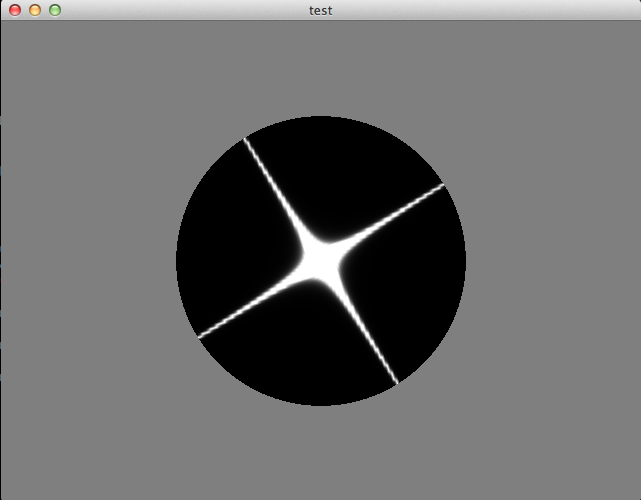Ищете простой пример OpenGL (3.2+) Python, который использует GLFW [закрыт]
Я ищу простой современный пример OpenGL (3.2+)в Python.
Я пробовал с GLUT и freeGLUT, но я не могу получить контекст 3.2 на OS X (Mavericks). (Это, по-видимому, известная проблема с GLUT/freeGLUT).
GLFW кажется современной легкой альтернативой перенасыщению, но, похоже, у него нет официальной привязки Python, и я не смог найти простой пример, который использует 3.2 основные профильные функции OpenGL с GLFW и Python.
(I боролся с этой проблемой, и поэтому это может быть полезно для других, я отвечаю ниже в соответствии с поэтому руководство.)
1 ответов
приведенный ниже код использует PyOpenGL, PIL (для текстур), включает в себя, GLFW и соответствующая привязка Python cyglfw3.
вот скриншот вывода:

основной код прилагается ниже. Он использует некоторые методы утилиты из файла с именем glutils.py (для загрузки текстуры, компиляции шейдеров и т. д.) который вы можете найти здесь:
https://github.com/electronut/pp/tree/master/simplegl
код следующим образом:
import OpenGL
from OpenGL.GL import *
from OpenGL.GLUT import *
import numpy, math, sys, os
import glutils
import cyglfw3 as glfw
strVS = """
#version 330 core
layout(location = 0) in vec3 aVert;
uniform mat4 uMVMatrix;
uniform mat4 uPMatrix;
uniform vec4 uColor;
uniform float uTheta;
out vec4 vCol;
out vec2 vTexCoord;
void main() {
// rotational transform
mat4 rot = mat4(
vec4( cos(uTheta), sin(uTheta), 0.0, 0.0),
vec4(-sin(uTheta), cos(uTheta), 0.0, 0.0),
vec4(0.0, 0.0, 1.0, 0.0),
vec4(0.0, 0.0, 0.0, 1.0)
);
// transform vertex
gl_Position = uPMatrix * uMVMatrix * rot * vec4(aVert, 1.0);
// set color
vCol = vec4(uColor.rgb, 1.0);
// set texture coord
vTexCoord = aVert.xy + vec2(0.5, 0.5);
}
"""
strFS = """
#version 330 core
in vec4 vCol;
in vec2 vTexCoord;
uniform sampler2D tex2D;
uniform bool showCircle;
out vec4 fragColor;
void main() {
if (showCircle) {
// discard fragment outside circle
if (distance(vTexCoord, vec2(0.5, 0.5)) > 0.5) {
discard;
}
else {
fragColor = texture(tex2D, vTexCoord);
}
}
else {
fragColor = texture(tex2D, vTexCoord);
}
}
"""
class Scene:
""" OpenGL 3D scene class"""
# initialization
def __init__(self):
# create shader
self.program = glutils.loadShaders(strVS, strFS)
glUseProgram(self.program)
self.pMatrixUniform = glGetUniformLocation(self.program,
'uPMatrix')
self.mvMatrixUniform = glGetUniformLocation(self.program,
"uMVMatrix")
self.colorU = glGetUniformLocation(self.program, "uColor")
# color
self.col0 = [1.0, 0.0, 0.0, 1.0]
# texture
self.tex2D = glGetUniformLocation(self.program, "tex2D")
# define quad vertices
quadV = [
-0.5, -0.5, 0.0,
0.5, -0.5, 0.0,
-0.5, 0.5, 0.0,
0.5, 0.5, 0.0
]
# set up vertex array object (VAO)
self.vao = glGenVertexArrays(1)
glBindVertexArray(self.vao)
# vertices
self.vertexBuffer = glGenBuffers(1)
glBindBuffer(GL_ARRAY_BUFFER, self.vertexBuffer)
vertexData = numpy.array(quadV, numpy.float32)
glBufferData(GL_ARRAY_BUFFER, 4*len(vertexData), vertexData,
GL_STATIC_DRAW)
# enable vertex array
glEnableVertexAttribArray(0)
# set buffer data
glBindBuffer(GL_ARRAY_BUFFER, self.vertexBuffer)
glVertexAttribPointer(0, 3, GL_FLOAT, GL_FALSE, 0, None)
# unbind VAO
glBindVertexArray(0)
# time
self.t = 0
# texture
self.texId = glutils.loadTexture('test.png')
# show circle?
self.showCircle = False
# step
def step(self):
# increment angle
self.t = (self.t + 1) % 360
# set shader angle in radians
glUniform1f(glGetUniformLocation(self.program, 'uTheta'),
math.radians(self.t))
# render
def render(self, pMatrix, mvMatrix):
# use shader
glUseProgram(self.program)
# set proj matrix
glUniformMatrix4fv(self.pMatrixUniform, 1, GL_FALSE, pMatrix)
# set modelview matrix
glUniformMatrix4fv(self.mvMatrixUniform, 1, GL_FALSE, mvMatrix)
# show circle?
glUniform1i(glGetUniformLocation(self.program, 'showCircle'),
self.showCircle)
# enable texture
glActiveTexture(GL_TEXTURE0)
glBindTexture(GL_TEXTURE_2D, self.texId)
glUniform1i(self.tex2D, 0)
# bind VAO
glBindVertexArray(self.vao)
# draw
glDrawArrays(GL_TRIANGLE_STRIP, 0, 4)
# unbind VAO
glBindVertexArray(0)
class RenderWindow:
"""GLFW Rendering window class"""
def __init__(self):
# save current working directory
cwd = os.getcwd()
# initialize glfw - this changes cwd
glfw.Init()
# restore cwd
os.chdir(cwd)
# version hints
glfw.WindowHint(glfw.CONTEXT_VERSION_MAJOR, 3)
glfw.WindowHint(glfw.CONTEXT_VERSION_MINOR, 3)
glfw.WindowHint(glfw.OPENGL_FORWARD_COMPAT, GL_TRUE)
glfw.WindowHint(glfw.OPENGL_PROFILE, glfw.OPENGL_CORE_PROFILE)
# make a window
self.width, self.height = 640, 480
self.aspect = self.width/float(self.height)
self.win = glfw.CreateWindow(self.width, self.height, "test")
# make context current
glfw.MakeContextCurrent(self.win)
# initialize GL
glViewport(0, 0, self.width, self.height)
glEnable(GL_DEPTH_TEST)
glClearColor(0.5, 0.5, 0.5,1.0)
# set window callbacks
glfw.SetMouseButtonCallback(self.win, self.onMouseButton)
glfw.SetKeyCallback(self.win, self.onKeyboard)
glfw.SetWindowSizeCallback(self.win, self.onSize)
# create 3D
self.scene = Scene()
# exit flag
self.exitNow = False
def onMouseButton(self, win, button, action, mods):
#print 'mouse button: ', win, button, action, mods
pass
def onKeyboard(self, win, key, scancode, action, mods):
#print 'keyboard: ', win, key, scancode, action, mods
if action == glfw.PRESS:
# ESC to quit
if key == glfw.KEY_ESCAPE:
self.exitNow = True
else:
# toggle cut
self.scene.showCircle = not self.scene.showCircle
def onSize(self, win, width, height):
#print 'onsize: ', win, width, height
self.width = width
self.height = height
self.aspect = width/float(height)
glViewport(0, 0, self.width, self.height)
def run(self):
# initializer timer
glfw.SetTime(0.0)
t = 0.0
while not glfw.WindowShouldClose(self.win) and not self.exitNow:
# update every x seconds
currT = glfw.GetTime()
if currT - t > 0.1:
# update time
t = currT
# clear
glClear(GL_COLOR_BUFFER_BIT | GL_DEPTH_BUFFER_BIT)
# build projection matrix
pMatrix = glutils.perspective(45.0, self.aspect, 0.1, 100.0)
mvMatrix = glutils.lookAt([0.0, 0.0, -2.0], [0.0, 0.0, 0.0],
[0.0, 1.0, 0.0])
# render
self.scene.render(pMatrix, mvMatrix)
# step
self.scene.step()
glfw.SwapBuffers(self.win)
# Poll for and process events
glfw.PollEvents()
# end
glfw.Terminate()
# main() function
def main():
print 'starting simpleglfw...'
rw = RenderWindow()
rw.run()
# call main
if __name__ == '__main__':
main()
